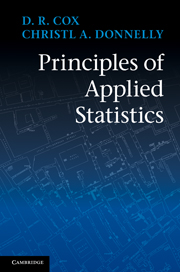8 - Techniques of formal inference
Published online by Cambridge University Press: 07 September 2011
Summary
Assessment of the uncertainty implicit in conclusions is often an important feature of statistical analyses. Although the primary emphasis in this book is not on the specialized concepts and methods involved in such assessments, the present chapter reviews the main ideas involved under the following headings: confidence limits, posterior distributions and significance tests.
Preliminaries
The details of specific statistical methods and the associated mathematical theory will not be discussed here. We shall, however, outline the main forms in which statistical conclusions are presented, because understanding of the strengths and limitations of these forms is essential if misunderstanding is to be avoided.
We discuss first analyses in which interpretation centres on individual parameters of interest; that is, in general we investigate component by component. We denote a single such parameter by ψ. This can represent some property of interest, such as the number of individual animals of a specific wildlife species in a particular area, or it can represent contrasts between groups of individuals in an outcome of interest or, in a linear regression application, ψ can be the slope of the relationship.
It is desirable that ψ is considered in ‘sensible’ units, chosen to give answers within or not too far outside the range from 0.1 to 10.For example, a slope of a relationship of length against time, that is a speed, might be in mm per hour or km per day, etc., as appropriate and an incidence rate might be in the number of cases per 100 000 person-years or in cases per 100 person-days.
Information
- Type
- Chapter
- Information
- Principles of Applied Statistics , pp. 140 - 158Publisher: Cambridge University PressPrint publication year: 2011
